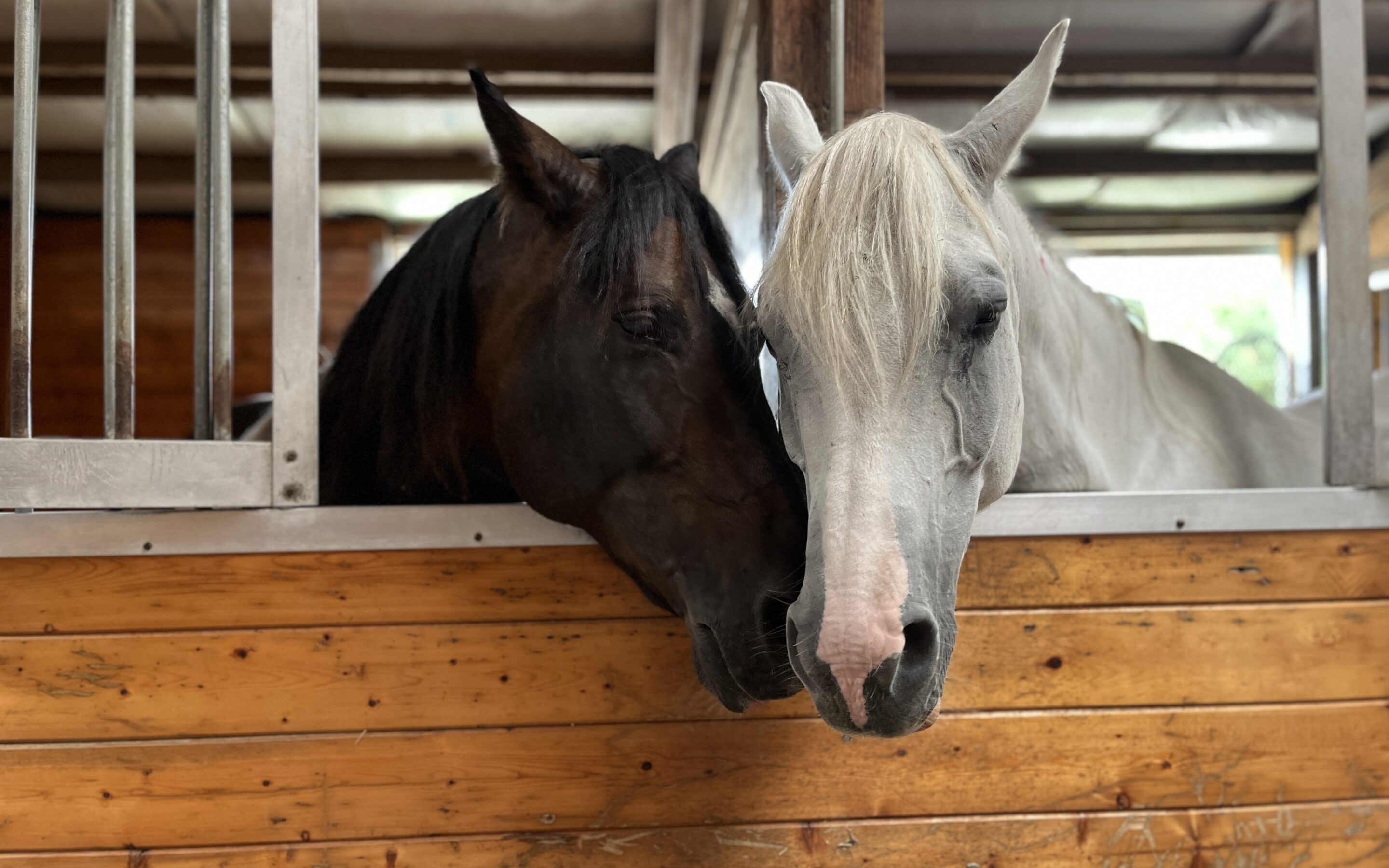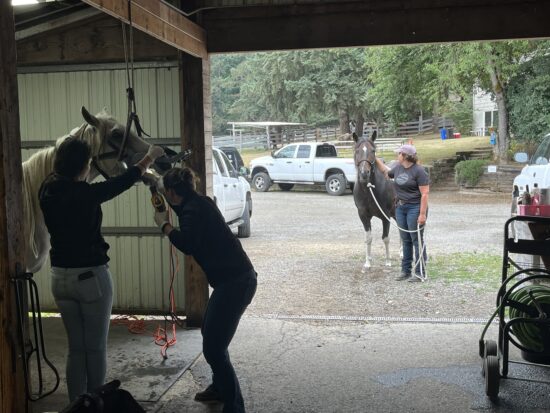Here is an example of the stars aligning at SAFE: The Friday after Scotty and Violet’s arrival, there was a vet appointment on the books. Two horses needed floats, along with several who were due for one vaccination or another. Two dentals and a few pokes is a light day, especially with cooperative patients, so there is often a little part of us that seeks something (non-emergency) to tack on.. or, that if there is an emergency, it waits until the day the vets are already set to arrive. (These days, while rare, inspire us to run out for a lottery ticket, if just because the odds seem too good). So you might be able to see why, when Scotty and Violet arrived on the Monday of a Vet Week, it sent a tingle of hope along our very-fond-of-convenience spines. New horses, with the chance to almost immediately see the vet. But some boxes needed to be checked first, some questions answered.
Were they… halterable? Yes! A resounding yes, as they let us scoop their cute little noses right up into our halters that Tuesday with minimal fuss.
Okay, but were they… handleable? (not a real word, and one that moves around the mouth like a marble, but you understand) Also yes! Or, Yes* would perhaps be more appropriate, for there were certain spots on Violet that would have you risking a kick if you were to try and palpate. No matter, the important areas for a vet day (neck, head, heart) were all accessible, which left us with one final question: could we lead them into the barn?
Dear reader, something you may or may not already know about horses is that they are much like humans. In the comfort of their own homes, they are often gentle beasts, greeting you with either a kind curiosity or a tepid indifference. But when they are new, especially when they are new, they can be quite agoraphobic when it comes to leaving the house. As the gate clangs shut behind them, and they step further from the space they know so well, they begin to grow antsy, uncertain. If they are new, then they likely do not know what it is to find much comfort in their handler. Hindquarters? What’s a hindquarters? They bravely traverse into a whole new world, where unfamiliar horses call, wheelbarrows rattle from behind corners, and Sunny and Shasta.. exist. The sight of miniature horses, for most, before they become acquainted, can shake even (and perhaps especially) the most stout draft horse to its core.
So when it comes to being able to lead new horses into the barn, results may vary.
Violet and Scotty are both half siblings and very good friends. Violet made this very clear to us from day one, where as we flitted around Scotty, brushing the tangles from his mane and wrapping a tape around his belly to estimate his weight, she was in turn draping her head over his back and threatening to kick him. Classic horse love. But this kind of codependency can be detrimental, debilitating, and dangerous (the three D’s of herdboundness — look for my academic paper to be released later this year). In this case, what it meant was that if we were to remove Violet from Scotty, or vice versa, the two of them, stuck like glue, would not make things easy. And while herdboundness is important to address, for the sake of being able to get their dentals done in a timely manner, we decided to work smarter not harder.
Not as much of a mastermind plan as I’m making it out to be. Really what we decided on was bringing them in, together, and allowing them to essentially hold each other’s hand in the waiting room. This is not an uncommon technique — Brandy and Bandit get the same treatment, and Domino typically gets an emotional support Lacey when he has to see the good doctor (Lacey, on the other hand, needs no one but herself). So for the few days leading up to the appointment, we did our own leading up: Violet and Scotty, to the barn.
Violet almost immediately proved to us how secure in herself she was, walking out of the paddock on that first day like she’d been doing it her entire life. Scotty followed closely behind, his anxiety quickening his feet, but his mind remaining sound and sane, even in the face of Sunny and Shasta, as well as a pair of horses working in the arena who called out to them as they passed. These were not feral wildlings, these were horses who had likely spent a good deal of time in barns, but you know what they say about assumptions. We want to set our horses up for success whenever possible, and if that means over preparing them to walk into a barn, then so be it. Tuesday, Wednesday, Thursday we haltered them up and made the brief trek into the grooming stalls where we host our dentals. There, we stood and groomed on them to hopefully lead them to associate positive feelings with the space. We clicked pens into their necks, mocking up how their shots of sedation would go. For each little test we put them through, they did remarkably well, and we could all but feel them rolling their eyes at us as if to say, “yeah, we’re ready, can we go back to our paddock now?”
Friday came, moment of truth, and we lined them up. Scotty first, as he tended towards the more anxious, and we felt it would be a kindness to slip him his drugs first. As he grew sleepy, Violet stood patiently by, wondering if she might be able to pick out some of those pesky weeds around the front of the barn while she waited her turn.
Despite his 13 years, there was no record we had of Scotty ever having had his teeth floated. Another reason for the rush to get these two seen: who knows what was going on in that untamed mouth? It turns out, not that much. Scotty’s teeth, barring a few sharp points, were in pretty great shape. We chalked it up to good genes. At this appointment, he was also scanned for a microchip, and when none was found, implanted with one, tying him to SAFE forever. We got him up to speed on his vaccines, which he was several years overdue for, and gave his sheath a good clean while he was docile and sleepy.
Violet’s appointment ran very similarly to her half-brother’s: her own mouth hadn’t seen a drill since 2017, but it too was in good shape, barring those same minor points. She also received a microchip and an update to her vaccines. Because of her high body condition score, our vets also suggested we draw blood to check her insulin and her thyroid levels, just in case. While her thyroid was normal, her insulin was just slightly over normal range — a figure that our vet expected to come down with weight loss.
Apart from Violet’s (over)weight, our vet gave them both a clean bill of health. We brought them into adjoining stalls to come out of their sedation, where Scotty, who was slightly more awake having gone first, called to his friend as she stumbled in next to him. We opened their windows as to avoid any stressful messes, where the two quickly reunited. Nose-to-nose, they slept off their drugs together, where, when they were sufficiently awake, they made the trek back to their paddock.
Another health-keeping note: the intake fecal we ran on them revealed the highest fecal egg count we have ever seen here at SAFE. Violet had a count of 2,168 EPG and Scotty had a whopping 3,416 EPG! We wonder if some of those extra lbs on Violet couldn’t have been caused by the ever so delicious sounding “worm belly.” We have since dewormed the pair, and have been monitoring them extra carefully in the event that such a serious parasite extermination causes any health events. So far, so good, and we hope that at our recheck fecal in a few weeks we see those numbers way, way down.
In the meantime, barring any emergencies, Violet and Scotty can check seeing the doctor off their list for the next little while.



